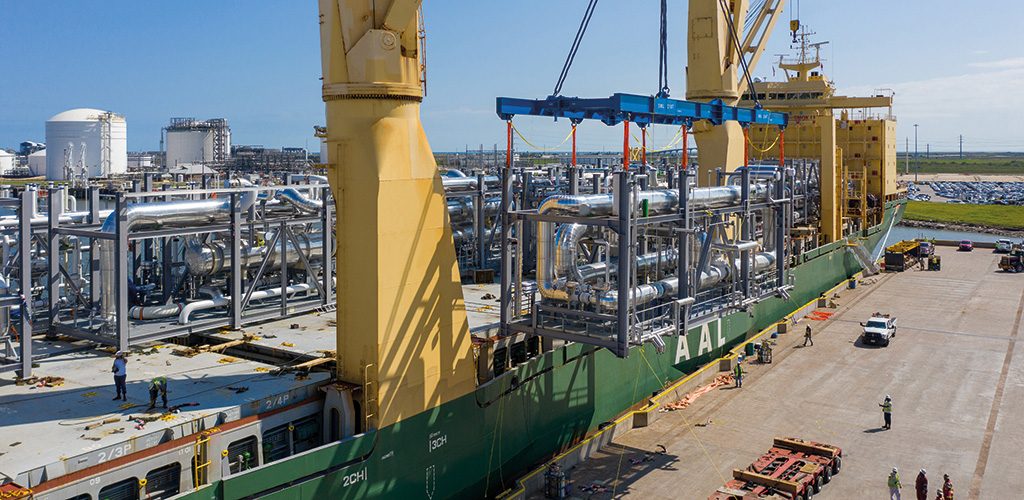Mar 11 | 2021
Ocean Shipping Poised for 2021 Growth, AAL GM Says

 By Michael Morland
By Michael MorlandThe U.S. market has seen a record number of multipurpose vessel, or MPV, calls in 2020, despite the havoc caused by the global pandemic and the trade war between China and the U.S. AAL has operated at least one sailing a month through the region and frequently more than one a month.
With a new U.S. administration in the White House, our faith in studies forecasting total annual investment of US$60 billion up to 2028 is increasing. The incoming administration’s commitment for a strong political push towards a greener environment is good for the wind industry, and makes an interesting contrast to the last four years of political leadership in the U.S., where much noise was made about supporting the fossil fuel and coal industries.
Because of the capital market nervousness over the fluctuation in oil prices, the U.S. oil market has not met the 2020 projections of investment of US$190 billion, and liquefied natural gas facilities have been hit hard with uncertainties surrounding funding issues on the back of a lack of long-term contract purchases at sustainable levels.
Despite this, throughput in 2020 increased our market share and sailing regularity. Our view is that large projects with billion-dollar capital expenditure have a very long lead time. The gap between the final investment decision and the order and manufacture of highly engineered equipment is usually counted in years rather than weeks or months. Therefore although some project equipment manufacture has been delayed by the Covid-19 pandemic, most projects continue to be reasonably unaffected by Covid-19 at this stage.
Stability for Oil Prices
Of course, there are other factors which are even more vital to the development timeline of such projects, the most important of which is the price of oil. With the price, stability and predictability of oil being a baseline for calculating project profitability, many new oil and gas projects have been pushed out in time. We expect that this will create a gap or void in the project pipeline that will affect cargo flow. This void is already starting to become visible in the smaller projects and cargoes with a shorter lead time. As a result, the longer the capital market decides to sit on the fence on investments in the oil and gas sector, the greater the void will be in terms of starting up new projects.
To illustrate this, when looking for “part cargoes” or “completion cargoes” to top-up some of our voyages, we have clearly noticed a significant drop in the volume of smaller cargoes in the market usually made up of smaller equipment, steel cargoes for multiple industry uses and other more regular cargo flows. This decrease is directly related to a drop in demand in the U.S.
That said, in the oil and gas sector, markets are recovering steadily and becoming more predictable and robust. While some projects and capital investment decisions have been postponed, it is likely that recovering and steadying oil prices should result in positive project investment decisions in the second half of 2021.
Nevertheless, these projects will not generate cargo movement for another year, so the effect will not be tangible in the short term.
As for wind energy generation, this sector’s demands have not waivered during the Covid-19 pandemic and the forecast is that demand will remain strong as long as the U.S. continues to invest in clean energy. The trend here is shifting towards larger and larger wind turbines.
For smaller project cargoes and other breakbulk, we foresee that once the Covid-19 pandemic subsides we will see an uplift in cargo volumes driven by companies trying to catch up with time lost and replenishing stock levels. Nevertheless, this could be months away and will very much depend on the overall economic impact of the Covid-19 pandemic in the U.S. – and indeed worldwide – and U.S. trade negotiations, which will hugely affect supply chains.
Biden’s Plans
I would also like to make some comments on how the president and his administration’s expected policies might impact the breakbulk trade climate. We see President Joe Biden looking to make more efforts in the Covid-19 fight. This could mean lockdowns in the short term, but an improvement of the situation in the long run. Coupled with increasing vaccinations, we hope that the U.S. will slowly improve in 2021 both from a population health and investment health perspective.
We believe this recovery has already been priced in by the markets, and the stability and predictability of an administration that takes on these issues will be welcomed by the finance and investment markets. We might see optimism that results in positive final investment decisions on some of the pending projects.
Biden is known for wanting to take the U.S. more rapidly towards the green transition that is happening elsewhere in the world. This will no doubt be a propellant for the wind industry and a launchpad for future projects, beyond what has already been committed to by previous administrations.
Another element that is of great interest is how Biden will address the country’s strained relationship with China, and how trade negotiations will shape up going forward. Although it is anticipated that the Biden administration will continue to take a stern line towards China, it is also expected that the negotiation climate will be conducted in a more productive way. Undoubtedly, an improvement in trade relations between the U.S. and China would be a huge positive for the breakbulk shipping industry as volumes will increase and demand for tonnage will grow.
Michael Morland is general manager for AAL Shipping in the Americas.
Image credit: AAL Shipping


